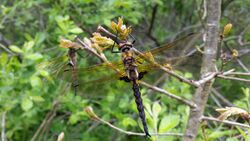Biology:Epitheca bimaculata
From HandWiki
Short description: Species of dragonfly
| Epitheca bimaculata | |
|---|---|

| |
| Male and female | |

| |
| Photographed in Lithuania | |
| Scientific classification | |
| Domain: | Eukaryota |
| Kingdom: | Animalia |
| Phylum: | Arthropoda |
| Class: | Insecta |
| Order: | Odonata |
| Infraorder: | Anisoptera |
| Family: | Corduliidae |
| Genus: | Epitheca |
| Species: | E. bimaculata
|
| Binomial name | |
| Epitheca bimaculata (Charpentier, 1825)
| |
| Synonyms | |
| |
Epitheca bimaculata, the Eurasian baskettail[1] or two-spotted dragonfly, is a species of dragonfly. It was described by Toussaint de Charpentier in 1825 and initially placed in the genus Libellula. It is the type species of the genus Epitheca.
Distribution
Its habitat ranges from Western France to Japan and eastern Siberia.[1]
It has been found in Western Europe, but here it is "rare and seen very irregularly".[3] It has also been found in Serbia,[4] and Kaliningrad Oblast, Russia.[5] Its occurrence in Hungary is "sporadic".[6] It also is found in Ukraine.[7]
Biology
It flies in May and June.[7]
Former subspecies
Two subspecies were recognized, but they were synonymized in 2004:[8]
- Epitheca bimaculata sibirica (Selys, 1887)[9]
- Epitheca bimaculata altaica Belyshev, 1951
References
- ↑ 1.0 1.1 1.2 Boudot, J.-P. (2020). "Epitheca bimaculata". IUCN Red List of Threatened Species 2020: e.T165482A140524274. doi:10.2305/IUCN.UK.2020-3.RLTS.T165482A140524274.en. https://www.iucnredlist.org/species/165482/140524274. Retrieved 20 November 2021.
- ↑ de Charpentier, Toussaint (1825), "Libellula bimaculata", Horae Entomologicae: Adjectis tabulis novem coloratis, Wratislavia: A. Gosohorsky, pp. 43–44, https://books.google.com/books?id=7CIVAAAAQAAJ&pg=PA43
- ↑ Martens, K. (1982). "New localities for Epitheca bimaculata (Charp.), with a review of its status in Western Europe (Anisoptera: Corduliidae)". Notulae Odonatologicae 1 (10): 157–159. http://natuurtijdschriften.nl/record/593285.
- ↑ Jović, Miloš; Andjus, Ljiljana; Santovac, Svetozar (2009). "New data on some rare and poorly known Odonata species in Serbia". Bulletin of the Natural History Museum 2: 102–103. http://www.nhmbeo.rs/upload/documents/casopisi/Glasnik/Vol02/Bulletin%20Vol2%20-%20Jovic%20et%20al.pdf.
- ↑ Buczyński, Paweł; Shapoval, Anatoly P.; Buczyńska, Edyta (2014). "Pantala flavescens at the coast of the Baltic Sea (Odonata: Libellulidae)". Odonatologica 43 (1/2): 5. http://wazki.pl/linkowane_publikacje/2014Odonatologica.pdf.
- ↑ Jakab, T.; Müller, Z.; Dévai, Gy.; Tóthmérész, B. (2002). "Dragonfly assemblages of a shallow lake type reservoir (Tisza-tó, Hungary) and its surroundings". Acta Zoologica Academiae Scientiarum Hungaricae 48 (3): 165. http://actazool.nhmus.hu/48/3/jakab.pdf.
- ↑ 7.0 7.1 Khrokalo, L. A.; Sheshurak, P. M. (2006). "Flight Seasonality of Dragonflies (Insecta, Odonata) in Northeastern Ukraine". Vestnik Zoologii 40 (2): 148. http://dspace.nbuv.gov.ua/handle/123456789/9430.
- ↑ Kosterin, O. E. (2004). "Odonata of the Daurskiy State Nature Reserve area, Transbaikalia, Russia". Odonatologica 33 (1): 56–57. http://natuurtijdschriften.nl/record/592459.
- ↑ de Selys-Longchamps, [E.] (1887). "Odonates de l'Asie Mineure, et révision de ceux de autres parties de faune paléarctique (dite européenne)". Annales de la Société entomologique de Belgique 31: 59. https://www.biodiversitylibrary.org/page/12279291.
Further reading
- de Charpentier, Toussaint (1840). Libellulinae europaeae descriptae ac depictae. Lipsia: Leopold Voss. pp. 10, 22, 57–58, 175. https://books.google.com/books?id=DoIwvgAACAAJ&pg=PP7.
- Steinmann, Henrik (1997). "Genus Epitheca Burmeister". World Catalogue of Odonata II. The Animal Kingdom. 111. Berlin: Walter de Gruyter. pp. 255–256. doi:10.1515/9783110824445.250. ISBN 9783110824445. https://books.google.com/books?id=gLZvT_njEF4C&pg=PA255.
Wikidata ☰ Q232693 entry
 |


